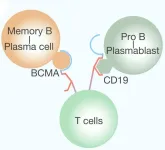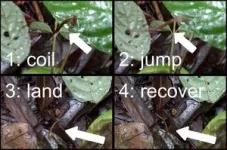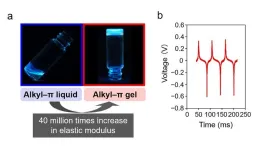(Press-News.org)
This study is led by Professor Junnian Zheng and Ming Shi from the Cancer Institute of Xuzhou Medical University, together with the team of Professor Guiyun Cui and Wei Zhang from the Affiliated Hospital of Xuzhou Medical University. The team reported for the first time using BCMA-CD19 bispecific CAR T cells for treating relapsed/refractory CIDP.
Chronic Inflammatory Demyelinating Polyneuropathy (CIDP) is an uncommon condition with sudden onset symptoms, including nerve damage affecting movement, sensation, speech, breathing, and heart rate. Over 80% of people develop muscle weakness, impaired gait, absent tendon reflexes, sensory loss, balance problems, and, in severe cases, paralysis, irregular heart rhythm, and difficulty breathing. Currently, treatments such as glucocorticoids, plasma exchange, and intravenous gamma globulin (IVIg) can help manage symptoms but cannot completely eradicate the disease.
In recent years, chimeric antigen receptor (CAR)-T cell therapy has achieved remarkable efficacy in hematologic tumors and many diseases represented by systemic lupus erythematosus. The team reported using BCMA-CD19 bispecific CAR T cells for treating relapsed/refractory CIDP.
B cell clearance coupled with anti-CD20 antibody has been used to treat CIDP. However, CD20 and CD19 are mainly found during earlier stages of B cell development and do not appear on long-lived plasma cells. Taking advantage of the BCMA protein's presence in plasma blasts and long-lived plasma cells, researchers at Xuzhou Medical University designed bispecific CAR-T cells that target both CD19 and BCMA, aiming to reset the balance of immune responses by temporarily and deeply eradicating B cells and plasma cells.
A 44-year-old man with relapsed/refractory CIDP exhibited distal limb numbness and weakness. Following the 2021 European Society of Neurology/Society of Peripheral Neurology CIDP Guidelines, he was diagnosed with distal CIDP without IgG4 autoantibodies. Post-admission evaluation and discussion led to his eligibility for bispecific CAR-T therapy for autoimmune disease, which he successfully underwent.
Following CAR-T cell therapy, the patient has made significant progress in functioning as per INCAT disability and MRC scores. Remarkably, almost full muscle power recovery was observed 180 days after CAR-T administration, paralleling his ability to walk again. Initially, it took them 21 seconds to cover a 10-meter walk, but by day 180, they managed it in just 13 seconds. Post-treatment electrophysiological assessments of median, ulnar, common peroneal, and tibial nerves showed significant improvement. After the initial 180-day follow-up, we checked in with them every 90 days to monitor any potential relapse. Remarkably, for more than a year, this patient could discontinue all immunosuppressants without disease recurrence, and the presence of GM4 and GD3 antibodies continued to diminish even after 3 months of CAR-T cell therapy.
Regarding safety, patients developed fever (38-39°C) and transient IL-6 elevation 6-14 days after CAR-T cell therapy and were treated symptomatic with acetaminophen. The patient developed hypotension (86-97/35-59 mmHg, grade 2) 1-15 days after CAR T cell infusion and recovered after 2 weeks of bed rest and plenty of water. No other toxicity associated with CAR-T cell therapy was observed.
This case shows how viable, well-tolerated, and effective BCMA-CD19 bispecific CAR T cells are for treating stubborn/repetitive CIDP. Even without continued immunosuppressants, remission stayed put despite B cell levels rising again. Also, it has the potential to help those suffering from autoimmune nerve disorders linked to B cells, such as neuromyelitis and myasthenia gravis.
This study highlights the change in patient symptoms after treatment and affirms the safety of CAR-T cell therapy for CID. While a single case report, more extensive studies, and extended follow-up, which is on the way, would add significant clinical value. It highlights the potential of CAR-T cell therapy in treating relapsed/refractory autoimmune disorders. This "dual-target" strategy is a promising step toward creating a potentially curable treatment for CIDP.
See the article:
Zhang W, Liu D, Zhang T, et al. BCMA-CD19 bispecific CAR-T therapy in refractory chronic inflammatory demyelinating polyneuropathy. hLife. https://doi.org/10.1016/j.hlife.2024.05.005
END
Advances in organoids and embryonic models of human development have the potential to prompt social and existential questions—e.g., what defines human individuality? However, bioethicist Insoo Hyun of Harvard Medical School and the Museum of Science in Boston says that these models have the potential to strengthen rather than weaken the concept of human individuality when considered within the philosophical frameworks of “personhood” and sentience. In a commentary publishing June 20 in the journal Cell, Hyun argues that despite huge advances, we are a long way off from developing technologies that would ...
Last year on a Friday evening, chemical biology researcher Josh Smalley was in the lab when he received a call inviting him to appear on the 14th and latest season of The Great British Bake Off. Starting as one of a group of 12 amateur bakers, Smalley made it all the way to the final round, where the top 3 contestants compete for the winning spot. In an essay published in the journal Cell Chemical Biology on June 20, Smalley describes the overlap between chemistry and baking and how his training in one ...
Scientists have discovered a new cause of why people who lack a specific blood group are genetically predisposed to be overweight or obese.
A team of international researchers, led by the University of Exeter, discovered that people with a genetic variant that disables the SMIM1 gene have higher body weight because they expend less energy when at rest.
SMIM1 was only identified 10 years ago, whilst searching for the gene encoding a specific blood group, known as Vel. One in 5,000 people lack both copies of the gene, making them Vel-negative. The findings from the new research suggest that this group is also more likely to be overweight, a conclusion ...
The discovery of a new, ancient, predatory reptile dubbed Parvosuchus aurelioi — part of a group of crocodile-like reptiles called pseudosuchians — in Brazil is described in a paper in Scientific Reports. The specimen, which dates to approximately 237 million years ago, during the Middle-Late Triassic, is the first small predatory reptile of its kind to be found in this country.
Prior to the dominance of the dinosaurs, pseudosuchians were a common form of ancient quadruped reptile during the Triassic Period (252 – 201 million years ago), with some species amongst ...
About The Study: The findings of this study suggest that increased maternal mental health symptoms during the COVID-19 pandemic are associated with subsequent changes in regional brain growth in newborn offspring.
Corresponding Author: To contact the corresponding author, Nickie Andescavage, M.D., email nniforat@childrensnational.org.
To access the embargoed study: Visit our For The Media website at this link https://media.jamanetwork.com/
(doi:10.1001/jamanetworkopen.2024.17924)
Editor’s Note: Please see the article for additional information, including ...
About The Study: In this case-control study of Chinese older adults, adhering to a healthy lifestyle appears to be important even at late ages, suggesting that constructing strategic plans to improve lifestyle behaviors among all older adults may play a key role in promoting healthy aging and longevity.
Corresponding Authors: To contact the corresponding authors, email Xiang Gao, M.D., Ph.D. (xiang_gao@fudan.edu.cn) and Xiaoming Shi, M.D., Ph.D. (shixm@chinacdc.cn).
To access the embargoed study: Visit our For The Media website at this link https://media.jamanetwork.com/
(doi:10.1001/jamanetworkopen.2024.17931)
Editor’s Note: Please see ...
A team of international researchers has revealed a new, simple clinical test to detect Calcium Release Deficiency Syndrome (CRDS), a life-threatening genetic arrhythmia that causes dangerously fast heartbeats and can lead to severe complications such as sudden cardiac arrest and death.
The new diagnostic method monitors for changes in electrocardiography (ECG) after a brief period of a fast heartbeat and a pause, which can occur naturally or be induced by artificially pacing the heart.
This research was co-led by Jason Roberts, a scientist at the Population ...
New Haven, Conn. — Patients with pancreatic cancer who received chemotherapy both before and after surgery experienced longer survival rates than would be expected from surgery followed by chemotherapy, according to a new study from researchers at Yale Cancer Center (YCC) and Yale School of Medicine.
The study, published June 20 in JAMA Oncology, included patients with pancreatic ductal adenocarcinoma (PDAC), which accounts for 90% of pancreatic cancers. An aggressive cancer with a high mortality rate, PDAC is predicted ...
A new study presents video evidence that at least one species of terrestrial leech can jump, behavior that scientists have debated for more than a century. Researchers from the American Museum of Natural History, Fordham University, and City University of New York (CUNY)’s Medgar Evers College published the footage and corresponding analysis today in the journal Biotropica.
“We believe this is the first convincing evidence that leeches can jump and do so with visible energy expenditure,” said lead author Mai Fahmy, a visiting scientist at the Museum and a postdoctoral researcher ...
1. A team of researchers from NIMS, Hokkaido University and Meiji Pharmaceutical University has developed a gel electret capable of stably retaining a large electrostatic charge. The team then combined this gel with highly flexible electrodes to create a sensor capable of perceiving low-frequency vibrations (e.g., vibrations generated by human motion) and converting them into output voltage signals. This device may potentially be used as a wearable healthcare sensor.
2. Interest in the development of soft, lightweight, power-generating materials has been growing in recent years for use in soft electronics designed for various purposes, such as ...





